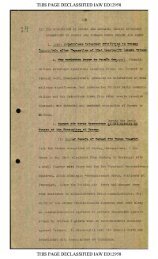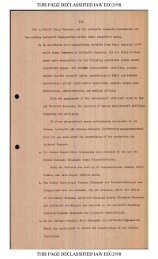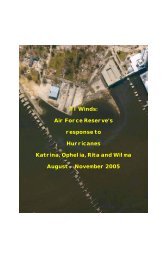Air Force Combat Units of WWII
Air Force Combat Units of WWII
Air Force Combat Units of WWII
Create successful ePaper yourself
Turn your PDF publications into a flip-book with our unique Google optimized e-Paper software.
484 AIR FORCE COMBAT UNITS OF WORLD WAR I1designated campaign areas <strong>of</strong> the EAMETheater.ASIATIC-PACIFIC THEATER: 7 December1941 to 2 March 1946.Philippine Islands: 7 December 1941 to10 May 1942. A few hours after the raidon Pearl Harbor on 7 December 1941,Japanese aircraft attacked the Philippines.Three days later Japanese troops landed onLuzon. America’s meager air power inthe islands was soon destroyed. Unable toobtain reinforcements and supplies, Mac-Arthur could do nothing more than fight adelaying action. Between 16 and 18 Decemberthe few bombing planes that remainedwere evacuated, by their crews,to Australia, where US air power in theFar East was to be concentrated. Othermembers <strong>of</strong> the air units took up arms andfought as infantrymen in the battle thatended, at Bataan and Corregidor, with theloss <strong>of</strong> the Philippines in May 1942.East Zndies: I January to 22 July 1942.While engaged in the conquest <strong>of</strong> thePhilippines, the Japanese thrust southward,landing troops in Sumatra, Borneo,Celebes, and elsewhere in the East Indies.Defeated in the Battle <strong>of</strong> the Java Sea atthe end <strong>of</strong> February 1942, the Allies lostJava. Then the Japanese put forces intoNew Guinea and the Solomons, on theroad to Australia. But a Japanese attemptto take Port Moresby early in May wasthwarted when the Japanese were beatenin the Battle <strong>of</strong> the Coral Sea.Paptra: 23 July 1942 to 23 January 1943.In another effort to take Port Moresby theJapanese landed xoops at Buna, Gona, andSanananda in July 1942. At first the Alliescould <strong>of</strong>fer only feeble resistance to theenemy forces that pushed southwardthrough Papua, but the Allies were buildingup their strength in Australia. BymidSeptember Fifth <strong>Air</strong> <strong>Force</strong> had superiorityin the air over New Guinea, andthe Japanese drive had been stopped. TheAllies then began to push the enemy back,with Fifth <strong>Air</strong> <strong>Force</strong> ferrying supplies andreinforcements to the troops fighting in thejungle. Buna was taken on 2 January1943, and enemy resistance at Sananandaended three weeks later.Guadalcanal: 7 August 1942 to 21 February1943. The seizure <strong>of</strong> Guadalcanalin June 1942 marked the high tide <strong>of</strong> theJapanese advance in the Southwest Pacific.U.S. Marines landed on the island on 7August and quickly took HendersonField, which was needed in order to gaincontrol <strong>of</strong> the air. The Japanese madeseveral attempts to retake the field, andthey repeatedly bombed the base to curtailAllied aerial activity. The contest, whichbecame one <strong>of</strong> reinforcement and supply,was decided when Japanese troop transportsthat were heading for the island weredestroyed by American ships and planesin November, but the Japanese held out onGuadalcanal until the following February.Northern Solomons: 22 February 1943to 21 November 1944. After the conquest<strong>of</strong> Guadalcanal, Halsey’s forces, supportedby Thirteenth <strong>Air</strong> <strong>Force</strong>, began a campaignto capture Japanese strongholds inthe Northern Solomons. In February 1943








